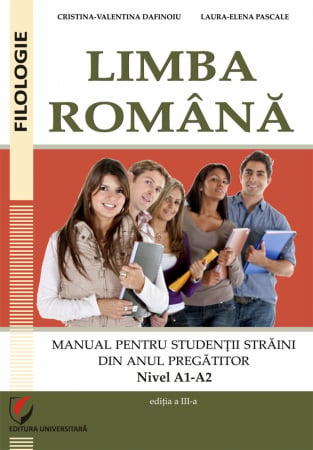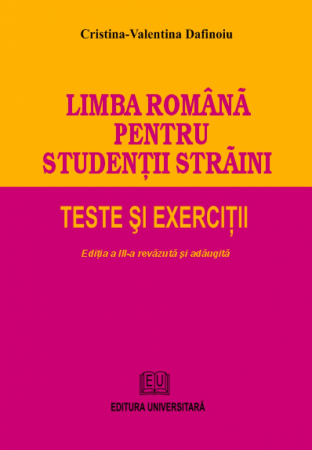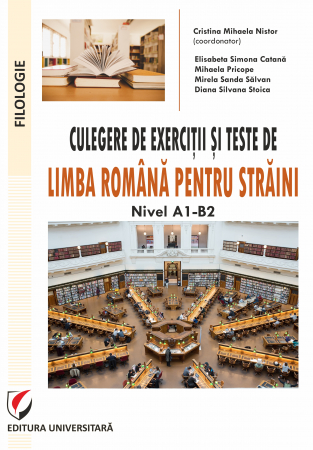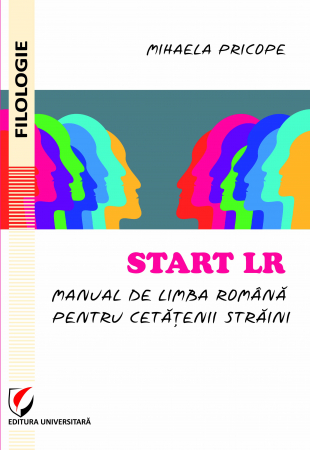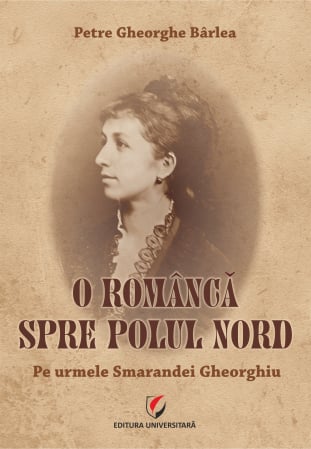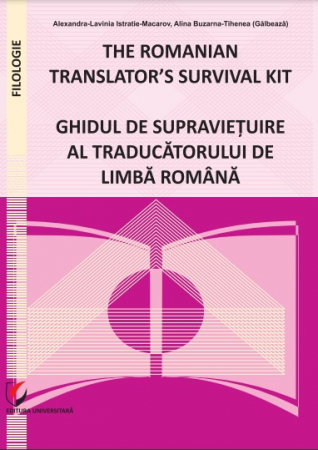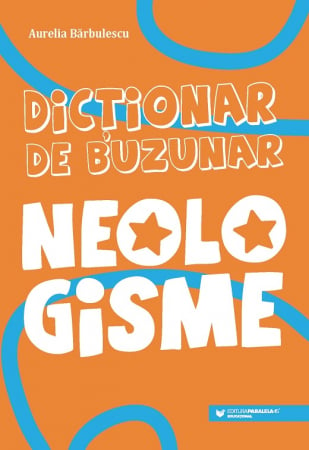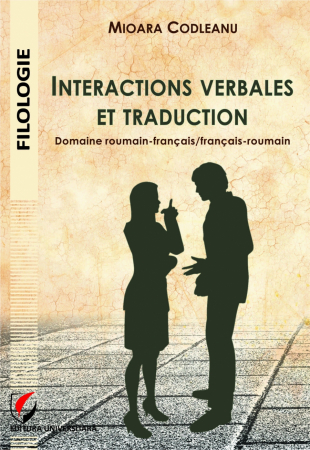Manuscript proposals: [email protected] / 0745 204 115 //// Tracking orders Individuals / Sales: 0745 200 357 / Orders Legal entities: 0721 722 783
ISBN: 978-606-28-0944-7
DOI: 10.5682/9786062809447
Publisher year: 2019
Pages:
Publisher: Editura Universitară
Author: Gyongyver Maduta
Edition: I
Product Code:
9786062809447
Do you need help?
0745 200 357
- Download (1)
- Authors
- Content
- More details
- Reviews (0)
-
Uncircumstantial complements in contemporary Romanian
Download
Gyongyver Maduţa
INTRODUCTION / 7
CHAPTER I. Elements of syntax history / 11
CHAPTER II. Direct and indirect complements in traditional Romanian grammars / 29
CHAPTER III. Direct and indirect complements in modern Romanian grammars / 44
3.1. General considerations / 44
3.2. The direct complement (object) / 51
3.3. Indirect complement / 70
CHAPTER IV. Direct and indirect complements in Romanian transformational and functional grammars / 89
CHAPTER V. The constitutive elements of the complements directly and indirectly. Comparative-conclusive approach / 114
5.1. Regentii / 114
5.1.1. Verb / 114
5.1.2. Adjective / 156
5.2. Ways to achieve the two syntactic positions / 178
5.3. Double expression of complements directly and indirectly / 180
5.3.1. Doubling the direct complement / 180
5.3.2. Doubling of the indirect complement / 187
5.3.3. Complementary considerations / 191
CONCLUSIONS / 195
NOTE / 196
ABBREVIATIONS AND ABBREVIATIONS / 197
BIBLIOGRAPHY / 200
CHAPTER I. Elements of syntax history / 11
CHAPTER II. Direct and indirect complements in traditional Romanian grammars / 29
CHAPTER III. Direct and indirect complements in modern Romanian grammars / 44
3.1. General considerations / 44
3.2. The direct complement (object) / 51
3.3. Indirect complement / 70
CHAPTER IV. Direct and indirect complements in Romanian transformational and functional grammars / 89
CHAPTER V. The constitutive elements of the complements directly and indirectly. Comparative-conclusive approach / 114
5.1. Regentii / 114
5.1.1. Verb / 114
5.1.2. Adjective / 156
5.2. Ways to achieve the two syntactic positions / 178
5.3. Double expression of complements directly and indirectly / 180
5.3.1. Doubling the direct complement / 180
5.3.2. Doubling of the indirect complement / 187
5.3.3. Complementary considerations / 191
CONCLUSIONS / 195
NOTE / 196
ABBREVIATIONS AND ABBREVIATIONS / 197
BIBLIOGRAPHY / 200
The appearance of the two academic grammars, Grammar of the Romanian language, Vol. I: The word, vol. II: The statement, coord. Valeria Gutu Romalo, Romanian Academy Publishing House, Bucharest, 2005 (GALR) and Basic grammar of the Romanian language, coord. Gabriela Pana Dindelegan, Univers Enciclopedia Gold Publishing House, Bucharest, 2010 (GBLR), brought, we could say, a "balance" in the field of Romanian linguistics, between "traditional" grammars, also called "logical", and "generative-functional" between these two extremes appearing modern grammars. We largely accepted, in this sense, the classification proposed by C. Dimitriu, Periodization of Romanian theoretical grammar, LR-LR, pp. 125–134, in grammars belonging to an old period, a modern one and a postmodern one, but we mastered and the proposals of Elena Tamba Danila, Old and new in the grammar of the Romanian language, "Demiurg" Publishing House, Iasi, 2004, where we talk about modern classical grammar. Finally, we used our own terminology, namely traditional grammar, including the old period of C. Dimitriu's classification, with works dominated by "logicism", modern traditional grammar, still under the influence of logical theories, but not obvious openings to modern concepts. , and generative-functional grammar, corresponding to the postmodern period in the classification of C. Dimitriu, without accepting the term proposed by the linguist from Iasi. The last academic grammars belong to this last period.
The two academic grammars have both a theoretical, even typological and a normative character, in the sense of constituting the basis for writing pedagogical grammars, without having such a quality themselves, a fact highlighted especially in GBLR, despite the request "from the school, to develop an intermediate tool to process the detailed description in the GALR for a didactic destination (emphasis added):" It would be completely wrong to believe that this new work is the same with a "school grammar". GBLR is not a textbook or a university textbook, but a paper that, keeping at a high theoretical level, corresponding to the theoretical level of the current scientific moment, aims to facilitate access to description data for as wide categories of readers ”(p. VII). It therefore aims to highlight "significant differences from the grammatical tradition, but also from GALR, so that the information of the new grammar becomes accessible to Romanian language teachers […]" (ib.), The pedagogical purpose becoming even clearer through the clarifications from final of the Preface.
Following carefully the manner in which linguistic research contributed to the achievement of this goal, we found that, in most cases, grammatical studies, in this case, syntactic remained strictly within the limits of the two directions mentioned above, not even a reference minimal information at the "opposite" point of view than, at most, at the area of research accepted and subject to investigation.
As such, we cannot speak of a sensible progress in "making accessible to Romanian teachers" the new conception, defined in GALR, as functional: "In the current version, the paper associates the descriptive aspect with the functional perspective on language […]" (p. IX).
From our point of view, the way that can facilitate the penetration of new theories and methods in the university and pre-university environment is that of comparing, we would say, "in the mirror" of language facts and their organization, the interaction of different components, as they are proposed. of "traditional" and "modern" grammars.
This is, in fact, the main objective of our thesis, with a circumscription to the direct complement and to the indirect complement.
We chose the two syntactic positions because they illustrate, in our opinion, the most conclusive syntactic mechanisms within the "verbal group", considered by transformational and functional grammars as the center of any statement. It seemed to us that revealing this mechanism is the most efficient way to prove the progress made by the approach offered by the new theories. We initiated this research considering, with small exceptions, the syntactic patterns at the level of competence, this being, in our opinion, the most productive procedure to highlight the differences between one description and another. We gave up the analysis of the corresponding subordinates in order not to exaggerate the dimensions of the work, but especially for the theoretical reason that subordinates are nothing but expansions of basic functions at the level of sentences, thus not bringing additional information on the relationship between complement and regent.
Since the modern Romanian grammars have suffered the influences of some important linguistic theories, especially Chomskyan ones, I considered it useful to give a description of some of the most present teeth in the Romanian synthesis studies. We gave up presenting the generative-transformational theses from N. Chomsky's work, they being amply commented in Romanian linguistics, and we focused on chap. I, Elements of the history of syntax, to the exposition of the (functional) theory of actors, elaborated by Lucien Tesnière, and to the "theory of cases" of Charles Fillmore, together with some interesting, newer data about Panini's "grammar".
Consistent with the regularization we discussed, we devoted chap. II Direct and indirect complement in traditional Romanian grammars. In fact, taking advantage of the appearance of the Grammar of the old Romanian language, by Constantin Francu, I presented the situation of the two complements in the old language. Regarding the grammars, we stopped at those that we considered representative for the period discussed, starting with the Grammar of Ion Heliade Radulescu and ending with the Romanian Grammar of H. Tiktin.
In cap. I presented, in extenso, the way the two complements are interpreted in modern (traditional) Romanian grammars, so that in chapter IV, the emphasis will fall on transformational and functional grammars, especially on GALR and GBLR.
Starting from the data thus accumulated and introducing new ones, we made a comparative chapter, V, entitled Constitutive elements of direct and indirect complements. We have thus compared the regents, the verb and the adjective, as the most important, the prototypical achievements and the double expression of the two complements, some problems that remain open today to new interpretations.
The thesis ends with a chapter of Conclusions and has the corresponding Bibliography.
Regarding the examples, we embraced the opinion that they must be reproduced as they appear in the analyzed works, for the reason that in many cases their choice expresses, implicitly, a cultural orientation of the authors.
Being a typological research, of the syntactic prototypes, based on the innovative grammars (and less on the imitative ones) of the Romanian language, we considered as the most adequate the procedure of direct references in the text, using only in strictly determined cases the notes, following that the Bibliography reveals the level and extension of the information that was the basis for writing this thesis.
The two academic grammars have both a theoretical, even typological and a normative character, in the sense of constituting the basis for writing pedagogical grammars, without having such a quality themselves, a fact highlighted especially in GBLR, despite the request "from the school, to develop an intermediate tool to process the detailed description in the GALR for a didactic destination (emphasis added):" It would be completely wrong to believe that this new work is the same with a "school grammar". GBLR is not a textbook or a university textbook, but a paper that, keeping at a high theoretical level, corresponding to the theoretical level of the current scientific moment, aims to facilitate access to description data for as wide categories of readers ”(p. VII). It therefore aims to highlight "significant differences from the grammatical tradition, but also from GALR, so that the information of the new grammar becomes accessible to Romanian language teachers […]" (ib.), The pedagogical purpose becoming even clearer through the clarifications from final of the Preface.
Following carefully the manner in which linguistic research contributed to the achievement of this goal, we found that, in most cases, grammatical studies, in this case, syntactic remained strictly within the limits of the two directions mentioned above, not even a reference minimal information at the "opposite" point of view than, at most, at the area of research accepted and subject to investigation.
As such, we cannot speak of a sensible progress in "making accessible to Romanian teachers" the new conception, defined in GALR, as functional: "In the current version, the paper associates the descriptive aspect with the functional perspective on language […]" (p. IX).
From our point of view, the way that can facilitate the penetration of new theories and methods in the university and pre-university environment is that of comparing, we would say, "in the mirror" of language facts and their organization, the interaction of different components, as they are proposed. of "traditional" and "modern" grammars.
This is, in fact, the main objective of our thesis, with a circumscription to the direct complement and to the indirect complement.
We chose the two syntactic positions because they illustrate, in our opinion, the most conclusive syntactic mechanisms within the "verbal group", considered by transformational and functional grammars as the center of any statement. It seemed to us that revealing this mechanism is the most efficient way to prove the progress made by the approach offered by the new theories. We initiated this research considering, with small exceptions, the syntactic patterns at the level of competence, this being, in our opinion, the most productive procedure to highlight the differences between one description and another. We gave up the analysis of the corresponding subordinates in order not to exaggerate the dimensions of the work, but especially for the theoretical reason that subordinates are nothing but expansions of basic functions at the level of sentences, thus not bringing additional information on the relationship between complement and regent.
Since the modern Romanian grammars have suffered the influences of some important linguistic theories, especially Chomskyan ones, I considered it useful to give a description of some of the most present teeth in the Romanian synthesis studies. We gave up presenting the generative-transformational theses from N. Chomsky's work, they being amply commented in Romanian linguistics, and we focused on chap. I, Elements of the history of syntax, to the exposition of the (functional) theory of actors, elaborated by Lucien Tesnière, and to the "theory of cases" of Charles Fillmore, together with some interesting, newer data about Panini's "grammar".
Consistent with the regularization we discussed, we devoted chap. II Direct and indirect complement in traditional Romanian grammars. In fact, taking advantage of the appearance of the Grammar of the old Romanian language, by Constantin Francu, I presented the situation of the two complements in the old language. Regarding the grammars, we stopped at those that we considered representative for the period discussed, starting with the Grammar of Ion Heliade Radulescu and ending with the Romanian Grammar of H. Tiktin.
In cap. I presented, in extenso, the way the two complements are interpreted in modern (traditional) Romanian grammars, so that in chapter IV, the emphasis will fall on transformational and functional grammars, especially on GALR and GBLR.
Starting from the data thus accumulated and introducing new ones, we made a comparative chapter, V, entitled Constitutive elements of direct and indirect complements. We have thus compared the regents, the verb and the adjective, as the most important, the prototypical achievements and the double expression of the two complements, some problems that remain open today to new interpretations.
The thesis ends with a chapter of Conclusions and has the corresponding Bibliography.
Regarding the examples, we embraced the opinion that they must be reproduced as they appear in the analyzed works, for the reason that in many cases their choice expresses, implicitly, a cultural orientation of the authors.
Being a typological research, of the syntactic prototypes, based on the innovative grammars (and less on the imitative ones) of the Romanian language, we considered as the most adequate the procedure of direct references in the text, using only in strictly determined cases the notes, following that the Bibliography reveals the level and extension of the information that was the basis for writing this thesis.
If you want to express your opinion about this product you can add a review.
write a review

6359.png)
![Uncircumstantial complements in contemporary Romanian - Gyongyver Maduta [1] Uncircumstantial complements in contemporary Romanian - Gyongyver Maduta [1]](https://gomagcdn.ro/domains/editurauniversitara.ro/files/product/large/complementele-necircumstantiale-in-limba-romana-contemporan-79-38910.jpg)
